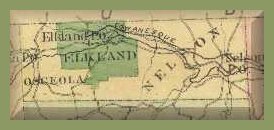|
Elkland Borough ,Tioga County PA Original article by Rose Watkins for Tri-Counties This page is part of the Tri-County Genealogy & History sites by Joyce M. Tice |
 |
|
|
|
|
|
Elkland Borough ,Tioga County PA Original article by Rose Watkins for Tri-Counties This page is part of the Tri-County Genealogy & History sites by Joyce M. Tice |
 |
Joyce:
I wrote to you about 3 or 4 months ago regarding the Cabbage Row in Elkland,Pa.
I have now found the Cabbage Row, it was in Elkland, PA, Taft Avenue. It was a group of Tannery owned house very small, originally only 3 rooms. It became the Cabbage Row because the houses looked like "little cabbages all in a row."
I now have the 1920 Census for Taft Ave. I am surprised by the diversity of the CABBAGE ROW. Immigrants from Austria, Hungary, Poland, Italy, and Russians that spoke German. I never knew Russians spoke German. Some say they spoke slavik language, but gave no dialect. There are about 4 pages. There were families from Florida, New York, and Michigan.
I found my mother, living at 16 Taft Avenue with her Father and stepmother and brother. Her father is a laborer and wage earner at the Tannery, Mother is 4 years old her brother is 6.
There was the "Colored Colony" so written on the side of the census by the census taker. I do not believe this could be written on a Census today. There were about 10 families named mostly from South Carolina. Tannery workers and vegetable farmers.
Also 2 pages of "Little Italy", tannery workers too.
The Cabbage Row still exists in Elkland today, I have walked it. The tannery is gone, there is a school there now. I believe I was told the electric company now in Elkland was part of the original Tannery. Still some of the families are third generation. This side of Elkland was a true company town, there was even a company store. The Elkland Tannery only made sole leather for shoes, and yes the Tannic Solution did cause polution in the waters around the area, the fish died.
I am told my grandfather and his brother who also lived on the Cabbage Row were "SLATHERERS". It was their job to go to the forest and get the tree bark necessary for Tannic Solution. I also have a description of the tanning process. I have also been told because animal hides came from all parts of the world, anthrax was a problem.
Rose Watkins
TAFT Avenue was the "CABBAGE ROW". Taft Avenue in 1920 was a diverse and impressive group of families. The Fourteenth Census of The United States gives us quite a view of the "CABBAGE ROW", and its neighbors. Laborers for the Tannery and their families, thirty-nine houses all totaled.
Austria, Poland, Italy, Russia, Germany, England, Slovakland, all listed here with Mother Tongues of their parents and themselves.
The United States was accounted for by Pennsylvania, New York, Virginia, Washington, D.C., Ohio, and Michigan, Maine, and more.
The Census Taker makes note of the "COLORED COLONY" on the side of the census form. Nine families mostly from the South, tannery workers, vegetable farmers and a laundress. Houses numbered 1-8, no street name. Possibly neighbors of the Cabbage Row by the numbering of the pages of the Census Sheets.
"Little Italy" again wrote by the census. Two pages, 50 lines per page, no street name, more tannery workers. Numbering suggests it was close.
Tanneries dated before 1812 in Tioga County. The Tannery in Elkland is dated to about 1852. By 1875 there were tanneries in Knoxville - W. D. Angel Tannery, Blossburg - Hoyt Brothers, Osceola - R. Hammond & CO., Westfield - Crary Garrett-Horton & CO., Tioga Township - E. Buyer Tannery, Delmar Township - Bailey Lowell & Co., Niles Valley - O. B. Lowell & Sons, Wellsboro - Joseph Riberolle.
The tanning process was a four-part process: 1. Beam House -- the hides are cleaned,
2. Tan Yard -- Various cuts of leather cropped and processed 3. Scrub House -- leather processed to improve color. 4. Rolling Loft -- drying and machine finishing for a high polish.
Working at the Tanneries did have its problems. Raw hides from all over the United States came in by rail. In the Beam House hides were cleaned of manure and extraneous matter, Anthrax was a known disease here, two of the symptoms staggering and convulsions.
The Tanning Liquor turned the waters red and killed the fish.
The Elkland Leather Company had a strike in 1937, a fire in 1947, and another fire in 1973. After the fire of 1973, it was never rebuilt. The Tannery fostered the Elkland Electric Company of today. Taft Avenue is still a part of Elkland.
The above information is from the author’s collection. Any comments are welcome and should be made directly to rosettawat@aol.com.